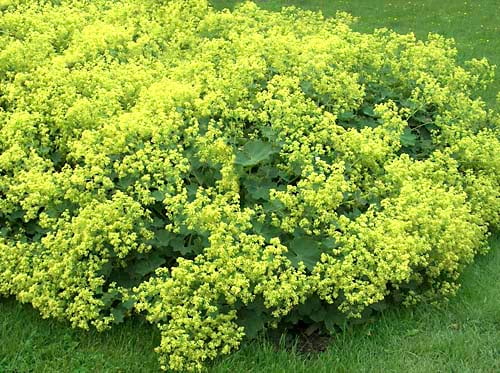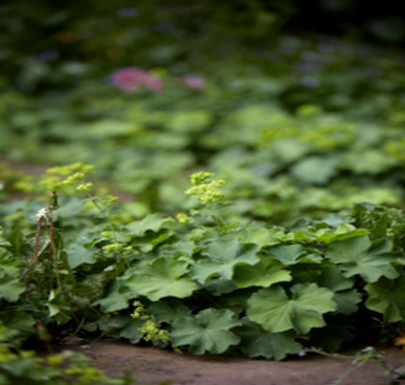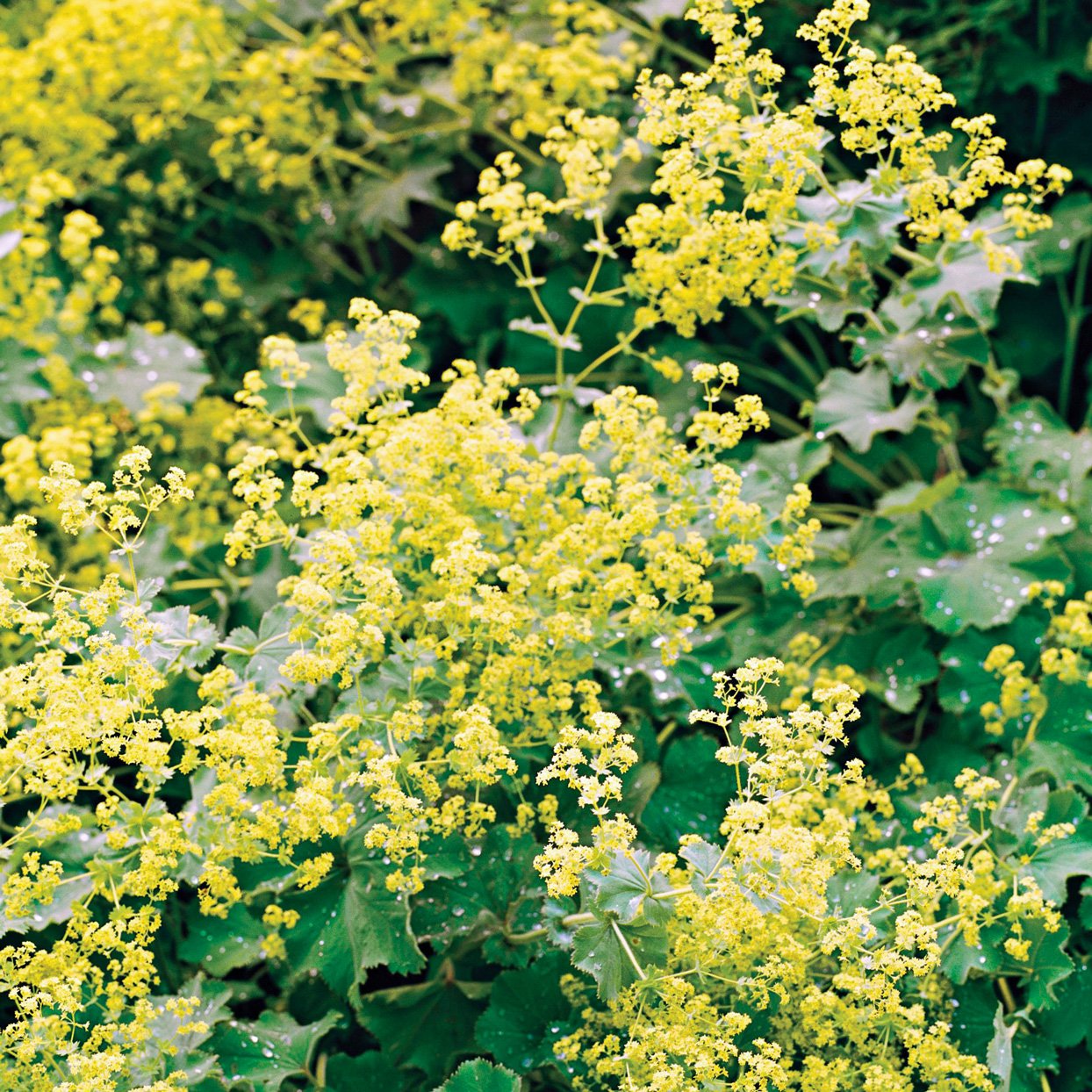Table of Contents
Lady’s Mantle, or Alchemilla Mollis (its biological name), is an old-fashioned herbaceous perennial plant, which grows up to 1-2 feet tall, with yellow flowers blooming from June-September.
These plants or flowers add an old and classy look to your garden, the one Queens would include in theirs. It will add an exotic charm to your garden and can also be used in making soaps or lotions.
This is one of those flowers which requires low maintenance to grow, blooms for the longest period, and goes well with any type of flowers or plants you have in your garden, all in all; it is an all-rounder.
Lady’s Mantle is sure to take your breath away when they bloom, but most lose their impact after flowering. These can go with any type of flower or plant, but they would go perfectly with shades of burgundy and purple foliage.
You can plant them both by using seeds or seedlings, make sure to plant them in early spring, or if you want them to come fast, you can directly seed them in fall, however, the new plants can take approximately 2 years to bloom.
How Can You Grow Lady’s Mantle?
The main question arises when you must grow a Lady’s Mantle, and obviously, unlike any other flower or plant, you must be careful of a few important factors while planting these. Few factors to keep in mind while planting Lady’s Mantle are –
Sunlight
These plants prefer the exposure of full sun to part shade for easy growing. It can tolerate the close sunlight to partly and is preferred to shade itself in the afternoon sun during hot climates.
You need to water it after every noon so that it will not get dry, when in shade, pair this plant with some fern leaves or hostas for an exquisite combination and look.
Your leaves might scorch up if you do not give them enough water, or too much exposure to the sun, so make sure to do both these things in a moderate amount.
Soil
Since Lady’s Mantle is a common growing plant, it does not have any preferences for the type of soil to grow in.
The basic acidic to neutral soil, of ph. 5.5-7.5 is required for this plant to grow. When adding mulch to your plant, add it to the ground, since the plant does not like it to go up.
Before planting your seeds, you can prep your soil with manure and fertilizer to ensure healthy growth. Keep the soil moist by watering it, but not soggy or the leaves will dry.
Water
These plants do not prefer sitting in wet soil, so you should keep your soil moist but not too wet.
These plants can withstand heat and dryness but to some extent.
When the climate is hottest and dry, it is recommended to water your plants so that they do not turn brown, hence, make sure to water them once per week.
When you pour water on the leaf’s early morning, they look gorgeous with the tiny droplets sitting on them looking like jewels.
Humidity
Lady’s Mantle can grow in zones 3-8, which practically means under any weather conditions, however, during hot climate, they prefer some shade.
If you live in an area with high humidity, your plants might develop fungus problem, to get rid of it, a good amount of air circulation or letting the soil be a little dry might help undo the problem.
Fertilizers
Lady’s Mantle do not need fertilizers to grow, however, if your soil is poor, you can use a slow-release organic fertilizer, during the time you plant in your seeds, to ensure proper and healthy growth.
However, if your soil is of the best quality then only adding manure and mulch is best.
Seeds
You can grow Lady’s Mantle with the help of seeds, seedlings, or divisions. If you want to grow the plants with the help of seeds, sow them directly after the frost has gone.
You need not cover the seeds fully, keep them a little open and water them regularly.
You can also first let the seeds germinate for about 3-4 weeks and then plant them in your soil.
You should start off with one plant and see how itself seeds itself, many gardeners use this trick.
You can also divide your Lady’s Mantle by dividing the plants in springs or late summers by the method of root division.

Varieties of Lady’s Mantle
There are at least 5 types of Lady’s Mantle leaves or flowers that you can grow in your backyard. All of them are incredibly gorgeous, low maintenance, and stays for a long period of time. You can grow whichever you want and enjoy looking at them.
Alchemilla Mollis ‘Thriller’
This type of plant has larger leaves than all the other Lady’s Mantle and a more upright growth habit, which means you must be extra careful with these.
Alchemilla Mollis ‘Auslese’
It too has an upright growth habit, and blooms rather lime-green leaves, which will look stunning in your backyard, along with other of your flowers in the flower bed, or even alongside the wall.
Alchemilla Mollis ‘Irish Silk’
This type of plant can grow for a maximum of 2 feet and produces a generous amount of leaves too. You can use this type to stand them against the wall.
Alchemilla Mollis ‘Robusta’
This plant also grows up to 2 feet tall and wide and features large leaves which means you can plant either Robusta or Thriller, whichever you want to. This plant is best under cold climate and is the longest living among all the others.
Alchemilla Mollis ‘Red Mantle’
This type of plant is called Red Mantle because it has red stems that contrasts perfectly with the chartreuse flowers alongside.
Also, the leaves this plant produces are blue green giving them a unique look.
Alchemila Alpina

This is a similar species of plant-like Alchemilla however it is much smaller than Alchemilla and has a silver lining on the edges of its leaves. You can use this type in your flower beds to give them a nice edgy look.
Alchemilla Mollis is the type of flower, which is present in every era, especially the old British era, you would find this type of flower in the palaces, or courtyards, or farmhouses or famous people.
But do not think that the flower itself is expensive because you see it in rich people’s homes, it is not, you can easily grow this flower in your backyard and have that feeling for yourself too.
How Can You Prune Lady’s Mantle?
Pruning your plant or flower is extremely necessary, this process involves cutting the parts of your plant or branch which are dead, basically unwanted, as they might hamper the growth of the rest of your plant if not cut down.
Lady’s Mantle can also sometimes grow out of control and you might need to prune it. What you need to do is deadhead the flowers as soon as they stop to self-seed themselves.
If you see your plant growing out of an undesired portion, or undesired manner, you need to pull it out immediately.
In some cases, you might need to cut up the entire plant, which does not mean that your plant is destroyed, it means that it will bloom again with new buds and leaves.
Conclusion
Alchemilla Mollis or Lady’s Mantle is a common plant which you can grow under any weather conditions, be it in north, south, east, or west, these can grow in the zones of 3-8.
You must have seen them outside your house several times being it one of the famous and easiest plants to grow.
With just the right number of factors you can grow Lady’s Mantle alongside your main wall, or place it in your flower bed, or outside your flower bed as a perfect lining.
These are the type of plants that you will find in palaces or big institutions, the place which has a class, and one always wonder if they are expensive and hence triggers away with the fact of growing them without having the full knowledge.
Flowers that are grown under specific climate and extreme care are the expensive ones, however, Alchemilla Mollis or Lady’s Mantle is an extremely unfussy, and low maintenance flower or plant you can ever grow, and which will give your whole backyard a rich, classy feel.
Plant your type of Lady’s Mantle now and give your flower bed that classy look.





